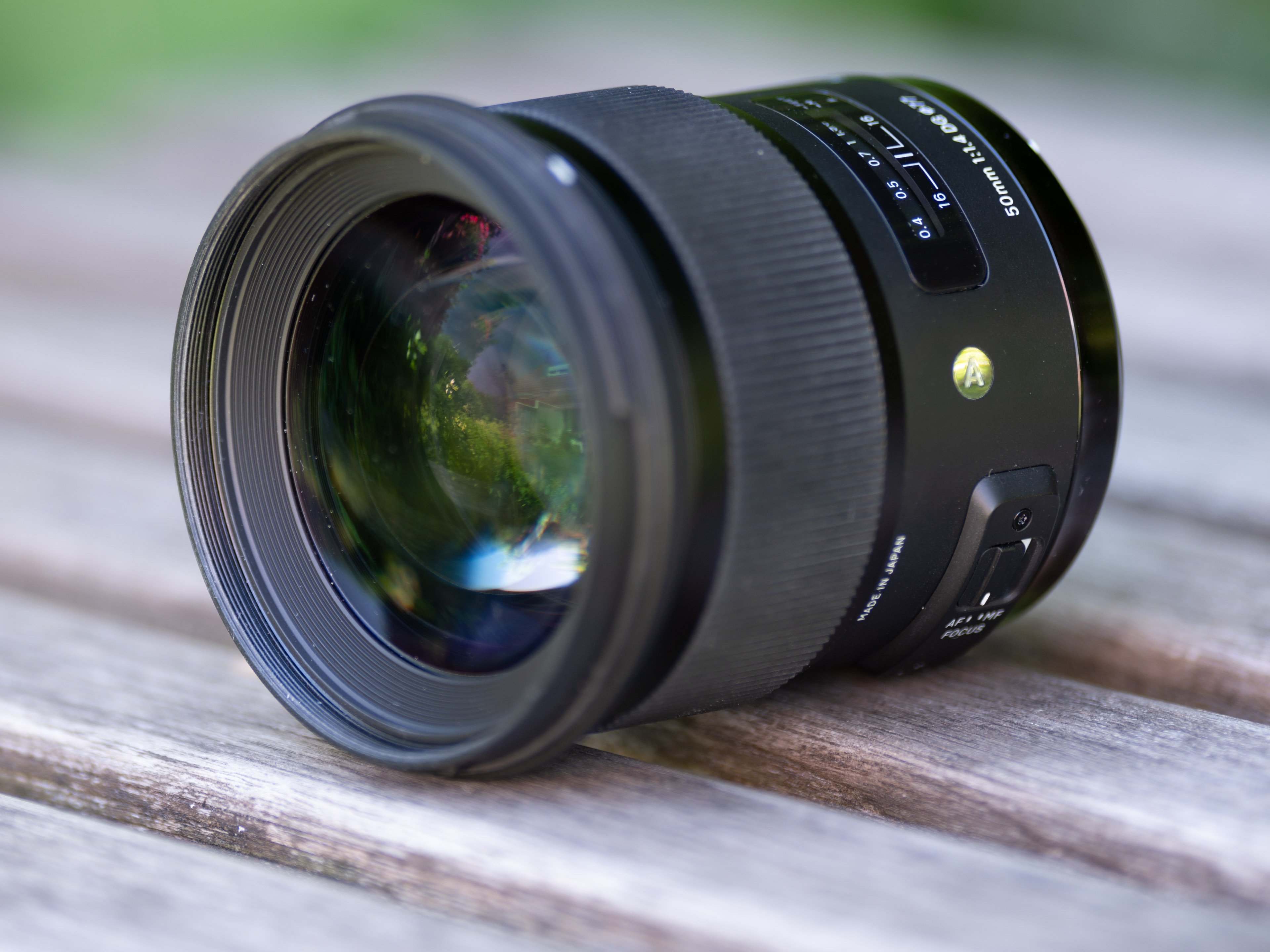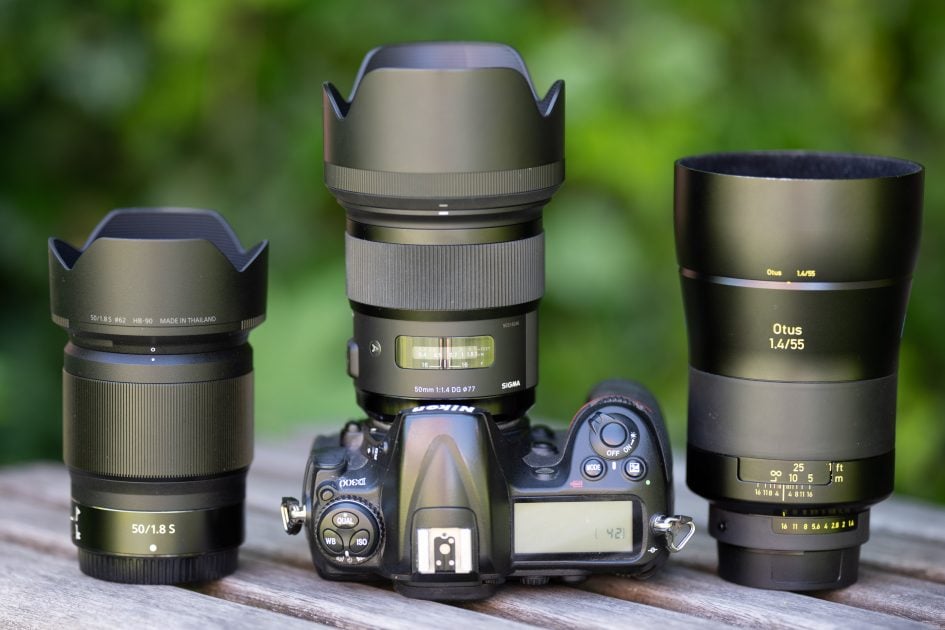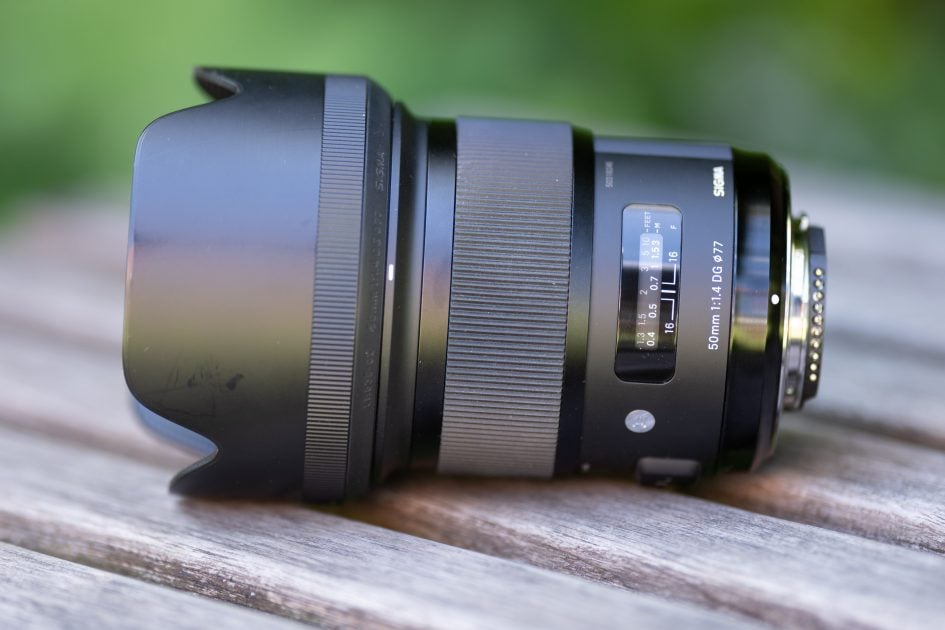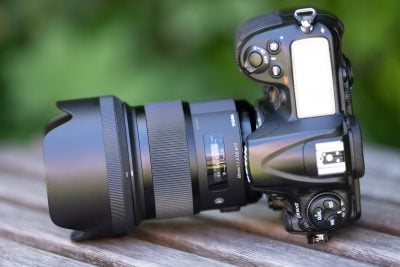
Sigma 50mm f1.4 Art review
-
-
Written by Thomas
Verdict
The Sigma 50mm f1.4 Art is a fitting member of Sigma’s renown Art series offering very high optical performance at prices that are comfortably lower than the professional lenses from either Canon, Nikon, Sony or Panasonic. It delivers very good image quality in the center even wide open at f1.4 when mounted on a 46MP full-frame body easily surpassing the performance of Canon’s or Nikon’s standard 50mm f1.4 lenses. And it shows a gradual softening toward the corners and a beautiful Bokeh which makes it a prime choice for portraiture.
But there are other 50/1.4 lenses to be had. So does the performance of the Sigma 50mm f1.4 ART match the corresponding mark-up in price, and what if you’re considering the Zeiss Otus, the most expensive ‘standard’ lens on the market? Let me go through all alternatives step-by-step.

Above from left to right: Nikon Z 50mm f1.8 S, Sigma 50mm f1.4 Art, Zeiss Otus 55mm f1.4 (Sigma and Zeiss in Nikon F-mount version)
Compared to Nikon AF-S 50mm f1.4G
The Nikkor 50mm f1.4G was for a while Nikon’s ‘top-of-the-range’ standard lens, although the introduction of the 58mm f1.4G means the lineup now shares a similar strategy to Canon. As such the 50mm f1.4G is positioned above the f1.8G version, providing a relatively affordable step-up from the ‘budget’ model, but comes in considerably cheaper than the flagship 58mm. This means the Sigma 50mm Art is positioned, price-wise at least, roughly between the Nikkor 50mm f1.4G and 58mm f1.4G.
Optically speaking the Sigma 50mm Art is superior to the Nikkor 50mm f1.4G in our tests. It’s sharper across the frame and suffers from fewer undesirable artefacts like bokeh outlining, vignetting or coma. But the Nikkor 50mm f1.4G is smaller and lighter, so it’s much easier to carry and looks inconspicuous mounted on any camera body.
Crucially the Nikkor 50mm f1.4G is cheaper than the Sigma 50mm Art, so like Canon’s EF 50mm f1.4 below, it’s a case of weighing-up whether you can afford to pay the extra for the Art as well as being happy to carry it around. If you can afford the extra price and don’t mind the size, the the Sigma Art is the way forward. But if your budget – or size desires – drive you towards the Nikkor 50mm f1.4G, it’s still a fine lens for the money.
For more details see my Nikon 50mm f1.4G review.
Compared to Nikon AF-S 58mm f1.4G
The Nikkor 58mm f1.4G is Nikon’s flagship standard lens for its DSLRs, yet it missed out on our top award in my review because its performance in the APS-C/DX and the full-frame/FX corner was a bit of a let-down for this price. As you can see in my review comparing the Sigma to this lens, the APS-C/DX corner of the Sigma is also a bit weaker than one could have hoped for but in the FX-corner the Sigma clearly prevails. The Nikon 58/1.4G generally has less loCA but compared to the Sigma suffers a bit from focus-shift and the resulting coloration plus astigmatism. Regarding coma both lenses are on the same pretty good level. The Sigma has the advantage in focus speed: 0.6 vs. 0.8 seconds.
Regarding build you have to weigh up (pun intended) the larger seize and heavier weight of the Sigma against its use of metal in the lens’s outer construction which gives it a feeling of very solid construction. But make no mistake: looks can be deceiving: the outer construction does not tell you anything about the quality and durability of the inner workings including the focus-drive. So the Sigma might or might not last longer than the Nikon. After all is said and compared I personally would prefer the new Sigma Art over the Nikon 58/1.4G even if the price was the same – so considering the Sigma Art is cheaper this is a strong recommendation.
For more details see my Nikon 58mm 1.4G review.
Compared to Nikon Z 50mm f1.8 S
The Nikon Z 50mm f1.8S is a very good standard prime lens for owners of Z-series mirrorless bodies: its optical performance is right up there with the much heavier and more expensive Zeiss 55mm f1.4 Otus including longitudinal color aberrations – which is no small feat. The size and weight of the Z Nikkor makes it a much better match for the compact Z-series bodies it’s designed for than the Sigma Art (plus FTZ adapter) although it is not the smallest lens itself. The Z-Nikkor also focuses fast and reliably and is sealed thoroughly – an important feature that is missing on the Sigma Art. And finally the lens produces quite pleasing Bokeh that’s not far behind the rendering of the Sigma Art lenses and to me, actually surpasses Nikon’s own 50mm f1.4G. This overall performance deserves a Highly Recommended!
For more details see my Nikon Z 50mm f1.8 S review.
Compared to Canon EF 50mm f1.4 USM
The EF 50mm f1.4 USM is Canon’s mid-range option out of a trio of 50mm lenses. Many Canon owners choose it as a step-up over the budget EF 50mm f1.8 II without investing the considerable cost in the flagship EF 50mm, but now the Sigma 50mm Art offers something in-between the mid-range and top-end Canon options in terms of price.
First things first, the Sigma 50mm Art is considerably heftier than any of the Canon EF 50mm lenses. It’s 85mm wide by 100mm long and weighs 815g in its EF-mount version. Compare that to the Canon EF 50mm f1.4 USM which measures 74x51mm and weighs 290g – this makes the Sigma wider, twice as long, and almost three times the weight. If you have a higher-end Canon body, the Sigma will feel well-balanced, but on smaller and lighter bodies the Canon lens will feel more in proportion.
In terms of optical quality, the Sigma 50mm Art exhibits higher contrast and sharpness across the frame. The Canon 50mm f1.4 roughly matches it in the middle of the frame at around f2.8, but in the corners of a full-frame image you’d need to close the Canon to f5.6 to come close. The Sigma also suffers from much less vignetting. In terms of Bokeh the Sigma also renders larger and more circular-looking blobs at the same aperture.
So optically the Sigma is definitely superior, but obviously it’s also larger, heavier and roughly double the price. I’d say it’s worth it if you can afford it and don’t mind accommodating the heft – and if it helps you justify the price, remember another advantage of the Sigma is being able to pay to switch mounts should you swap camera systems in the future, thereby protecting your investment. Oh and it comes with a lens hood too.
Compared to Canon EF 50mm f1.2L USM
Canon’s EF 50mm f1.2 L USM has always been a benchmark for Canon owners, a lens which most photographers, especially portrait ones, aspire to having in their collection. It has the joint brightest aperture of any lens in the current Canon EF catalogue, and is the only 50mm in the EF range to carry the ‘L’ status. So what if it also carries a price tag to match? It’s the lens to go for if you’re a Canon owner who wants the best 50mm around, right?
Well, I’d say there’s a new King in town: Sigma’s 50mm f1.4 Art enjoys better sharpness and contrast in the middle of the frame, and delivers noticeably superior performance in the full-frame corners. The Canon suffers from far greater vignetting at apertures greater than f2.8, and doesn’t even come close to the corner sharpness until it’s closed to f5.6 or even f8.
Ah, but the 50mm f1.2 isn’t about sharpness I hear you cry – it’s all about the beautiful Bokeh. But while the Bokeh balls are indeed bigger on the Canon at f1.2, I wouldn’t say they look any better. There’s much more squashing into cats eyes at the largest apertures, and the shape of the 8-blade iris becomes more obvious as you stop-down. I also noticed slices cut from the Bokeh balls at f1.2 and f1.4 from the Canon due to the camera’s mirror box, which just wasn’t a problem for the Sigma.
Admittedly the Sigma is a bigger lens: it shares the same maximum diameter as the Canon 50mm f1.2, but is roughly 50% longer and heavier, so you really know you’re carrying it around. But considering the Sigma delivers superior results across the board and comes in at two thirds to half the price depending on region, it becomes a no-brainer to me, and that’s before you even factor in the ability to switch its mount (at a cost) to a different system should you move from Canon in the future.
I’ll admit there is still a thrill to having a lens which can open to f1.2, but in my tests the Sigma simply out-performed the Canon across the board and at a lower price. If you want the best 50mm with autofocus for your Canon DSLR or mirrorless via an adapter, the Sigma 50mm f1.4 Art is it. Canon has since released a newer, higher quality 50mm f1.2L lens, but only in the RF lens mount for its full-frame EOS R mirrorless cameras. This is an outstanding lens, but one that’s considerably pricier than the Sigma. See Gordon’s Canon RF 50mm f1.2L USM review for more details.
Compared to Sony FE 50mm f1.4 ZA
The Sony FE 50mm f1.4 ZA is a very respectable large aperture standard prime lens for Sony’s mirrorless bodies. It’s very sharp in the center and produces one of the best full-frame corners I’ve seen. Plus its resistance against flare and glare in adverse contra-light situations is commendable. Its Bokeh is good albeit not best in class and it can be a little slow to focus. But it is sealed thoroughly and offers a de-clickable aperture ring, a feature that is pretty useful for filming. But the Sigma Art has one of the best Bokehs of a 50mm lens and it produces a very sharp center with a gradual softening towards the corners – a characteristic that many prefer for portraiture. But that also means that it is softer at the APS-C-corner and the FF-corner than the Sony FE 50mm f1.4 ZA. Regarding longitudinal color aberrations and focus-speed the Sigma Art is comparable or even better than the Sony. And it might be a bit bigger and heavier than the Sony but not exceedingly so. With a price that is only half of the Sony FE 50mm f1.4 ZA and the overall performance the Sigma 50mm f1.4 Art is a very attractive alternative.
For more details see my Sony FE 50mm f1.4 ZA review.
Compared to Zeiss Otus 55mm f1.4
This is the optical reference regarding sharpness and contrast at every distance and it also sports very low longitudinal CA. But it is even larger and heavier and four times as expensive as the Sigma Art. Plus it has one big deficit: no auto-focus! Looking closer into the resolution results the new Sigma Art even manages to beat the mighty Otus by a small amount in center performance and it shows less light fall-off in the corners. That is an outstanding feat. Regarding Bokeh the Sigma Art and Zeiss Otus are pretty close with the Zeiss producing the bigger Bokeh balls in the center but having a stronger cat’s-eye effect towards the corners.
Unfortunately the Sigma’s wide-open performance in the center drops towards the corners even of an APS-C sensor. But make no mistake: it’s performance is still good to very good there. In addition to corner resolution the Sigma Art falls behind the Zeiss Otus in three other aspects: field-curvature, loCA, flare/glare-resistance. So the old adage still holds true: you get what you pay for.
For more details see my Zeiss Otus 55mm f1.4 review.

Sigma 50mm f1.4 Art final verdict
The Sigma 50mm f1.4 Art is without a doubt a very good standard lens with autofocus for Canon, Nikon, Panasonic Lumix S or Sony full-frame cameras. You’d expect it to out-perform the cheaper Canon EF 50mm f1.4 USM and Nikkor 50mm f1.4G lenses considering it’s roughly twice the price, but the big surprise is how it also delivers better performance in most aspects than the Canon EF 50mm f1.2L USM and the Nikkor 58mm f1.4 and is neck-and-neck with Sony’s FE 50mm f1.4 ZA despite both these lenses coming-in at almost twice the price.
When you also consider Sigma offers a service (paid) to switch mounts should you swap camera systems in the future, there really isn’t any reason not to get the 50mm Art if you can afford it. Once again it offers a step-up from the cheaper models and was also preferable to Canon and Nikon’s premium standard lenses in our tests. The only downsides are greater longitudinal chromatic aberrations than the more expensive rivals and the fact the body isn’t weather-sealed.
So it’s the best standard lens with AF under 2000 USD, but what if you can stretch even higher and you’re also willing to manually focus? Can the Sigma 50mm f1.4 Art compete against the mighty Zeiss Otus costing four times the price? The short answer is it actually comes very close, but the Otus remains the optical champion whatever else you’ve read. Just look at our results pages: the Otus is sharper in the far corners, is better at avoiding lateral chromatic aberrations, and suffers from less coma and virtually no field curvature. The Otus is optically superior. But whether this performance is worth four times the price is a decision only you can make – and remember it’ll also involve manual focusing which rules it out for many photographers.
So the Sigma 50mm f1.4 Art is a very good lens out-performing lenses even costing twice the price. It sets a very high bar for price/performance ratio of 50mm f1.4 lenses and easily earns our Highly Recommended award. Below I have listed the good and bad points of the lens for you.
Good points:
- Very good to excellent performance across a high-resolution full-frame sensor even wide open.
- Fast and reliable auto-focus.
- Minimal light fall-off for an f1.4 lens.
- Solid build quality.
- Lower price than professional f1.4 lenses.
- Chance to fine-tune using optional USB dock.
- Only standard lens that can swap mounts (at a cost) between Canon EF, Nikon F, Sony E, and Leica L-mount.
Bad points:
- Higher price than basic 50mm f1.4 lenses.
- Large and heavy.
- Not weather-sealed.
- Some field-curvature makes stopping down mandatory for high-quality shots of flat (or distant) subjects.
- Outlining sometimes makes the background Bokeh a bit nervous.
- Greater Longitudinal Chromatic Aberrations than top models
Check prices on the Sigma 50mm f1.4 Art at Amazon, B&H, Adorama, or Wex. Alternatively get yourself a copy of my In Camera book or treat me to a coffee! Thanks!




